“If you’re getting close to those levels — and again this (draft study) was just released — just the idea that those compounds are present, is a reason for people to sample and to understand the extent of the issue better,” said Paul Buszka, a supervisory hydrologist with the U.S. Geological Survey in Indianapolis.
EARLIER: Water quality expert: Dayton chemical concerns demand monitoring, attention
The chemical compounds turned up in March at Dayton’s Ottawa Water Treatment Plant, the first time the compounds — believed to be safe when below 70 ppt for lifetime exposure — were detected in water after the treatment process.
Michael Powell, director of the city of Dayton Water Department, reiterated Thursday that the public has little to fear, but said the city is stepping up testing — including trying to pinpoint the source of the compounds.
The city has more than 300 monitoring wells, adding 80 in the last six months. Already, a number of wells have been shut down in fear of drawing more PFAS into the system.
The precise origin of the compounds detected in the treated water is yet unknown. But regulators have prodded both the city of Dayton and Wright-Patterson Air Force about the chemicals once used as a fire retardant, ones the Ohio EPA says the Air Force has been slow to clean up.
“Ohio believes strongly WPAFB needs to be more proactive to address PFAS at its source before this contamination can impact additional drinking water wells (either Dayton’s or WPAFB’s). Ohio EPA continues to focus on ensuring Dayton’s and WPAFB’s drinking water wells remain below the current U.S. EPA health advisory level in both water systems,” according to a statement to this news organization.
RELATED: Water danger: Wright-Patt among many military bases where chemicals detected
Base officials responded: “Wright-Patterson is committed to protecting human health and ensuring safe drinking water and continues to comply with Ohio EPA requirements. We expect to award a contract later this month on an expanded site inspection which will include continued quarterly sentinel well monitoring at the base boundary as well as the installation of additional monitoring wells. We will also continue to meet with the Ohio EPA and other stakeholders monthly to share analytical data.”
Initially, the source of PFAS in the Dayton water was believed to be Wright-Patterson Air Force Base, but then later testing showed The Dayton Fire Training Center on McFadden Avenue could also be a potential source.
“I don’t want to rule out any one,” Powell said. “We are looking at any of the data gaps in our system so that we should be able to pinpoint where potential sources are … It’s too early at this point to give a pinpoint definitive answer.”
In emails and letters sent to customers this month, both Dayton and Montgomery County officials stressed that level was significantly below the EPA health advisory limit of 70 ppt for lifetime exposure.
If the Agency for Toxic Substances and Disease Registry’s draft study is eventually adopted, Dayton’s water — as well as many systems across the country — may not meet future benchmarks, but the designation could allow water providers more support to fix the problem.
MORE: Chemicals found in local water prompt new alerts to customers
“While the report does not contain specific standards and should not be regarded as a notice of a threat to public health, we believe the recommendations in the report will help the federal EPA quickly develop necessary national health research and clean up standards for states to use,” the Ohio EPA responded in a statement Thursday.
U.S. Rep. Mike Turner, R-Dayton, applauded the release of the draft findings Thursday, which he had pushed the administration to do.
“This is a matter of public health and safety,” Turner said in a statement. “Based on this information, I encourage federal, state, and local environmental regulators to examine whether they are appropriately communicating the risks presented by and adequately addressing the presence of PFOS and PFOA in drinking water. We must ensure agencies at all levels are using the most reliable data and best available science to ensure our drinking water remains safe.”
MORE: Secrets of Dayton’s blue lagoon revealed
Other experts reacted to the study carefully.
“Looks like the lower exposure levels may be of concern, although I have not had time to read carefully,” said Rita Loch-Caruso, a professor of toxicology and water expert at the University of Michigan
RELATED: Dayton water chemicals prompt warning to local residents
“So what advice to give? It is hard to say without a more careful review,” Loch-Caruso added.
Joyce Dinglasan-Panlilio, chair of the Sciences and Mathematics Division and associate professor of environmental chemistry at the University of Washington-Tacoma, said it’s difficult to say whether Dayton’s water can be considered safe or not.
“Having investigated these compounds for a long time now, I do want people to know that these are synthetic compounds that have no known natural sources,” she said in an email Thursday. “Thus, finding them in drinking water at any level should be something we take seriously.”
“The places where these have been found in drinking water sources have been impacted by known sources typically related to use of aqueous fire-fighting foams in airports or military facilities, hence something that we can potentially eliminate,” Dinglasan-Panlilio added.


